What Does the Star Method Stand for
We're about to discuss behavioral interview questions and the STAR method, but first:
Tomorrow's my interview. I'm so nervous that I'm sweating bullets. They're going to ask me all kinds of questions, and their randomness makes it difficult to prepare for.
I wish there was a way I could answer their questions perfectly, every time; I wish there was a secret method or strategy .
Well, you're in luck!
There is a special formula that works every time when tasked with answering behavioral interview questions: the STAR Method.
So, get ready to ace your upcoming interview with this STAR interview format guide and tutorial on how to answer STAR interview questions.
This STAR method interview guide will show you:
- An explanation of what the STAR interview technique to help you understand and apply it in your next job interview.
- How to tackle behavioral-based interview questions using the STAR method.
- What is a behavioral interview question and how you can answer it.
- Over a dozen examples of behavioral interview questions and answers using the STAR approach.
Want to land more job interviews? Create the perfect resume in our builder:
- Pick a professional template.
- Get expert resume tips from recruiters.
- Edit and download your resume in minutes.
Start getting more job offers. See 20+ resume templates and create your resume.
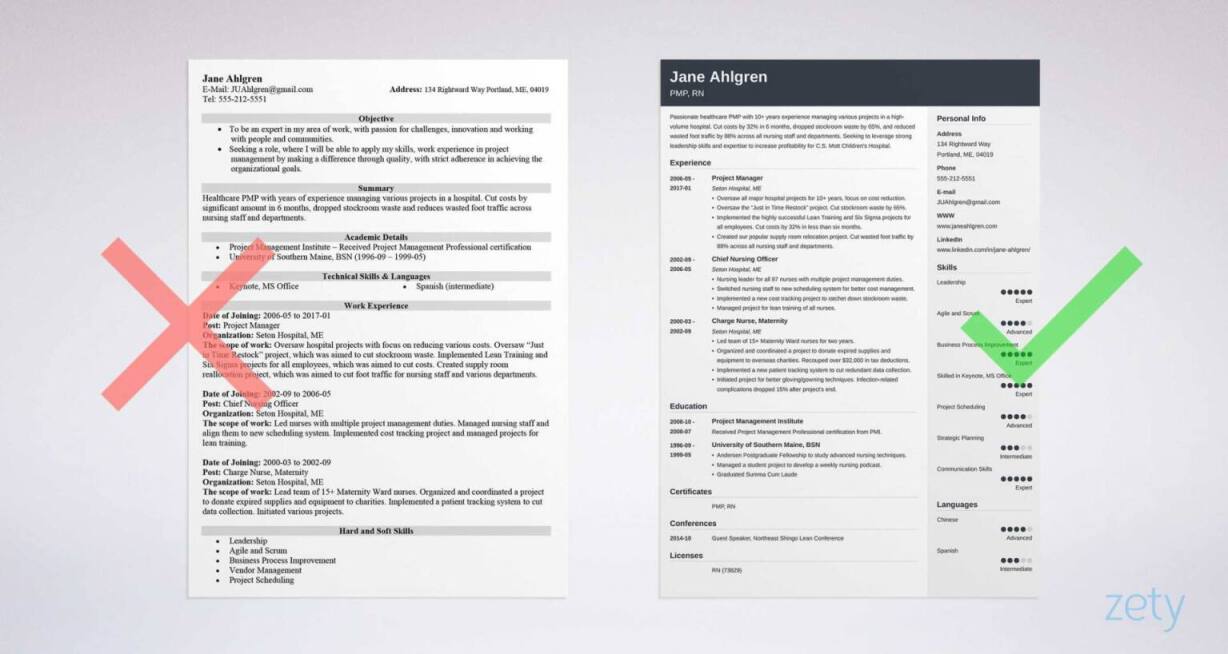
Sample resume made with our builder — See 20+ templates and create your resume here
1
What is the STAR Method?
The STAR method is a technique of answering behavioral interview questions in a structured manner by describing a specific situation, task, action, and result of the situation you are discussing. The STAR method helps you explain in a simple yet powerful way how you handled specific work situations and challenges.
The STAR format stands for Situation, Task, Action, Result:
-
- Situation: An event, project, or challenge faced
- Task: Your responsibilities and assignments for the situation
- Action: Steps or procedure taken to relieve or rectify situation
- Result: Results of actions taken.
The STAR interview method is also called the CAR method, which stands for Context/Challenge, Action, Result. They're essentially the same approach, with the Context of the CAR technique being equivalent to the Situation and Task of the STAR technique. It is synonymous, too, with the PAR method, which stands for Problem, Action, Result.
Pro Tip: The STAR technique is perfect for all aspects of job hunt. It lets you talk about achievements on your resume rather than boring tasks and responsibilities, too!
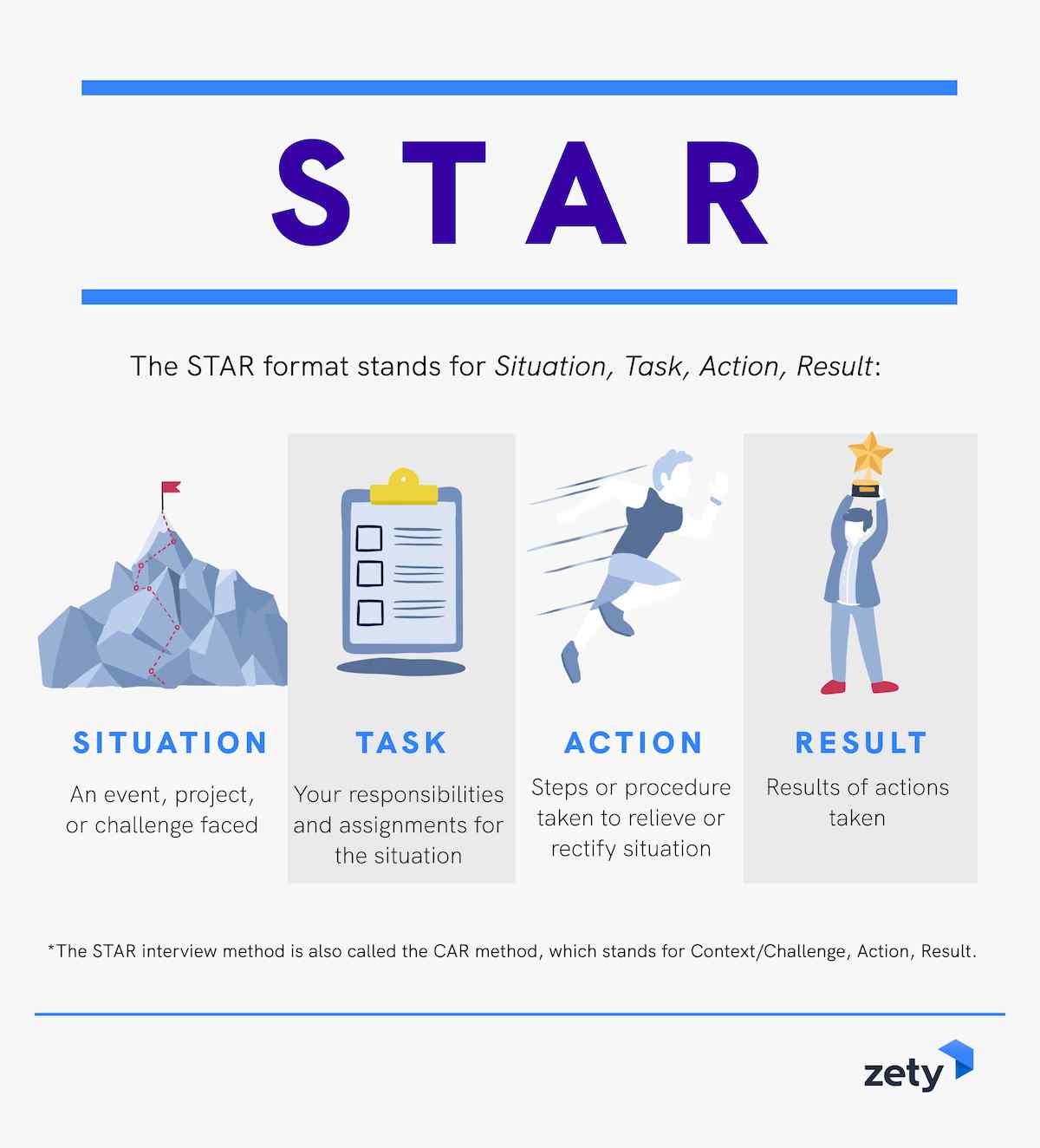
Sounds pretty simple, right?
Sure, but how do those four words solve my interview worries on behavioral questions?
We'll answer that in just a moment, but first, we'll go over what behavioral questions are in the next chapter.
The STAR method is one of the greatest behavioral interview tips, but we've got tons of interview advice for all stages of your big day: Best Job Interview Tips, Advice and Techniques
2
Behavioral Interview Questions - An Explanation
So, what are behavioral interview questions?
Behavioral interview questions are questions about specific situations in your past work experience and how you handled them or behaved.There are the essence of the STAR method of interviewing.
In this approach, the recruiter assesses your answer to see if you are capable of taking proper initiative and action should a similar situation take place.
Behavioral interview questions are one of the biggest pain points for interviewees. The recruiter isn't looking for a simple answer, like a "yes/no," but rather a semi-detailed story.
And, even if you have no work experience, behavioral questions and answers can be associated with other situations, such as university projects or volunteering responsibilities.
Behavior-based interview questions often start in similar ways, such as:
- "Tell me about a time when..."
- "Give me an example of..."
- "Have you ever..."
- "Describe an instance where you've had to..."
Ok, so now you get the gist, but let's take a quick quiz to find out if you really understand where we'll apply the STAR method.
Which of the following is an example of a behavioral question?
[A] Give me an example of how you would handle an irate customer phone call.
[B] Tell me about a time when you performed well under enormous pressure.
[C] Where do you see yourself in five years?
So, what's your answer?
Well, the correct option is [B]. Option[C] is clearly not of the behavioral types of interview questions, and [A] was a trick— it starts the way many behavioral questions do but is actually a situational interview question.
Pro Tip: Situational interview questions focus on speculative events in the future. Instead of giving the interviewer an actual event and how you handled it from your past work experience, a situational answer considers how you might act in a situation that might happen in the company's future.
As for answer [C], you can check out our great article to prepare for this important question: "Where Do You See Yourself in 5 Years?" Interview Question [Examples]
3
How to Use the STAR Approach to Answer Behavioral Interview Questions
Well, we know what behavioral questions in job interviews are, and we know the basic concept of the STAR method, as well.
But how do we combine the two to make you the star of the interview?
Let's use the above[B] as a lesson on how to answer an interview question using the STAR approach:
"Tell me about a time when you performed well under enormous pressure."
Step 1. Using the STAR method to answer this question, we'll first start with describing the situation:
One time, at my last job, my coworker had a family emergency and needed to miss work for some time, and their super-important project was left unfinished and without a manager.
Step 2. Next, we'll give them the task:
My supervisor instructed me to take on the project, and with no leniency on the deadline, I had days to complete a project that originally should have taken several weeks.
Step 3. Then the action taken to solve the problem:
I requested and was granted a reduction in my weekly goals, allotting me more time to attack the special project. As far as my weekly goals, I was able to delegate them out evenly to some of my teammates.
Step 4. And finally, the result of your actions:
With the reduction in my daily goals, I was able to dedicate more time to the special project. This allowed me to finish it on time and with complete accuracy. My supervisor appreciated my attitude and drive, and I was given several more projects after that, along with an eventual promotion and pay raise.
See that? It might have been a long story for an answer, but following the STAR interview format will give you detailed responses the interviewer expects when asking a behavioral-based interview question.
And, it's not too hard to do, either. As long as you work out each step in the STAR method in order, you'll nail your answer and impress them while you're at it.
Pro Tip: When answering in the STAR formula, use the first person singular - "I did such-and-such" rather than "we did such-and-such" - it will keep the focus on you.
At your interview, there'll come a time when you'll have the opportunity to ask them some questions, as well. Don't get caught off guard: 65 Questions to Ask an Interviewer (Examples for Specific Jobs)
When making a resume in our builder, drag & drop bullet points, skills, and auto-fill the boring stuff. Spell check? Check. Start building aprofessional resume template here for free.
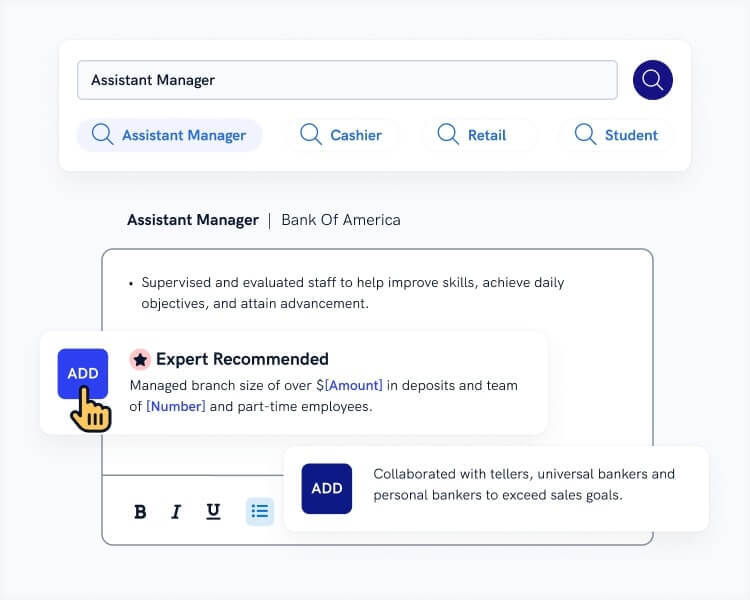
When you're done, Zety's resume builder will score your resume and tell you exactly how to make it better.
4
Behavioral Questions & Examples of STAR Answers
Not as hard as you thought, right?
You understand the STAR format interview, as well as what a behavioral interview question is and how to answer it.
Now, let's look a list of typical STAR interview questions and answers:
Top 10 behavioral interview questions & STAR answers
1. Tell me about a time you had a conflict at work.
STAR Model Answer: There was a disagreement I had with a coworker which originated from a miscommunication. To keep our work environment professional and positive, we had to discuss it and make amends. I sat down with them one day during lunch, paid for their meal, and took initiative by apologizing for my part in the whole mess. Now, we work together well and are often praised for our impressive teamwork.
2. Can you describe a stressful situation and how you handled it?
STAR Model Answer: At my last restaurant, I once found out mere hours in advance about a health inspection. As the head chef, I was in charge of making sure everything was in order in the kitchen and the BOH before the inspector arrived. I quickly called in employees from the last shift to help out, leaving the others available to prep for that evening's dinner. As a result, we were able to ace the inspection, less costly in the long run compared to giving employees a few hours of overtime.
3. Can you detail a mistake you made and how you reacted to it?
STAR Model Answer: One time, I switched the packing labels of two packages I sent to customers. I had to correct the problem without angering the clients. I called them both up and provided them with shipping labels with the correct addresses while offering each of them a small gift certificate to use on a future order. The customers not only helped me fix my mistake, but they were both satisfied and will return and shop again.
4. Tell me about a time when you performed well under enormous pressure.
STAR Model Answer: At my last job, my coworker needed to miss work for some time, and their project was left unfinished and without a manager. My supervisor instructed me to take on the project, and with no leniency on the deadline, I had days to complete a project that originally should have taken several weeks. I requested and was granted reduced weekly goals, giving me more time to finish the special project. As far as my weekly goals, I was able to delegate them out to teammates. With my reduced goals, I dedicated more time to the special project. This allowed me to finish it on time and with complete accuracy. My supervisor appreciated my attitude and drive, and I was given several more projects after that, along with an eventual promotion and pay raise.
5. Have you ever dealt with a sticky situation involving another department?
STAR Model Answer: Previously, my department had a misunderstanding with members of our accounting department. We needed to correct the issue to keep office morale from plummeting. I gave my team a small budget and instructed my team to each pick out a thoughtful present for their counterpart in accounting. Later that night and from then onward, we became friends and strong colleagues.
6. Give me an example of a goal you met.
STAR Model Answer: Last October, I had to write six articles for the month to keep our blog fresh. I created an action plan for myself, with deadlines as to when each article should be published. I finished that month with six articles written and ahead of schedule.
7. Give me an example of a goal you couldn't meet and how you handled it.
STAR Model Answer: Last November, I had to write six articles for the month to keep our blog fresh. Throughout the month, I was tasked with small responsibilities that took time away from my goal. I was unable to complete my six posts, but I talked to my supervisor and detailed all my extra work completed, and I was praised for my accomplishments, as well.
8. Tell me about a time when you had to placate an unsatisfied client.
STAR Model Answer: As a flight attendant, I had a passenger who seemed to hate his seat next to a wailing infant. I decided to see what I could do to ease his suffering before he complained. With unoccupied seats in business class, I upgraded that passenger, and he was thrilled at his luck while the mother and infant were given more room to spread out.
9.Have you ever had a disagreement with an immediate supervisor?
STAR Model Answer: I once disagreed with my supervisor on the wording of her instructions. As her employee, I had to balance my respect for her with my English lessons from school. Instead of shoving a dictionary in her face, I apologized for the confusion and told her that I saw where we became confused. She respected me much more after that, and she even gave her recommendation for my promotion.
10. Describe a time when you went above and beyond.
STAR Model Answer: Earlier this year, there was a day where I had to come in to the garden center on a Saturday and take care of some tasks on which we were behind. I came in, listening to my headphones the entire time, and ended up finishing everything before lunch. As I was in such a productive mood, I stayed the full day, and eventually completed tasks that were meant for the following few days. Since that day, the garden center has never fallen behind again.
Reread the STAR interview questions and answers examples above for inspiration. Notice it's not important what you have to talk about. It's important how you do it.
Pro Tip: Some interview questions may not literally be questions at all, such as "Describe a time when such-and-such happened. . ." They could still require a STAR response, though!
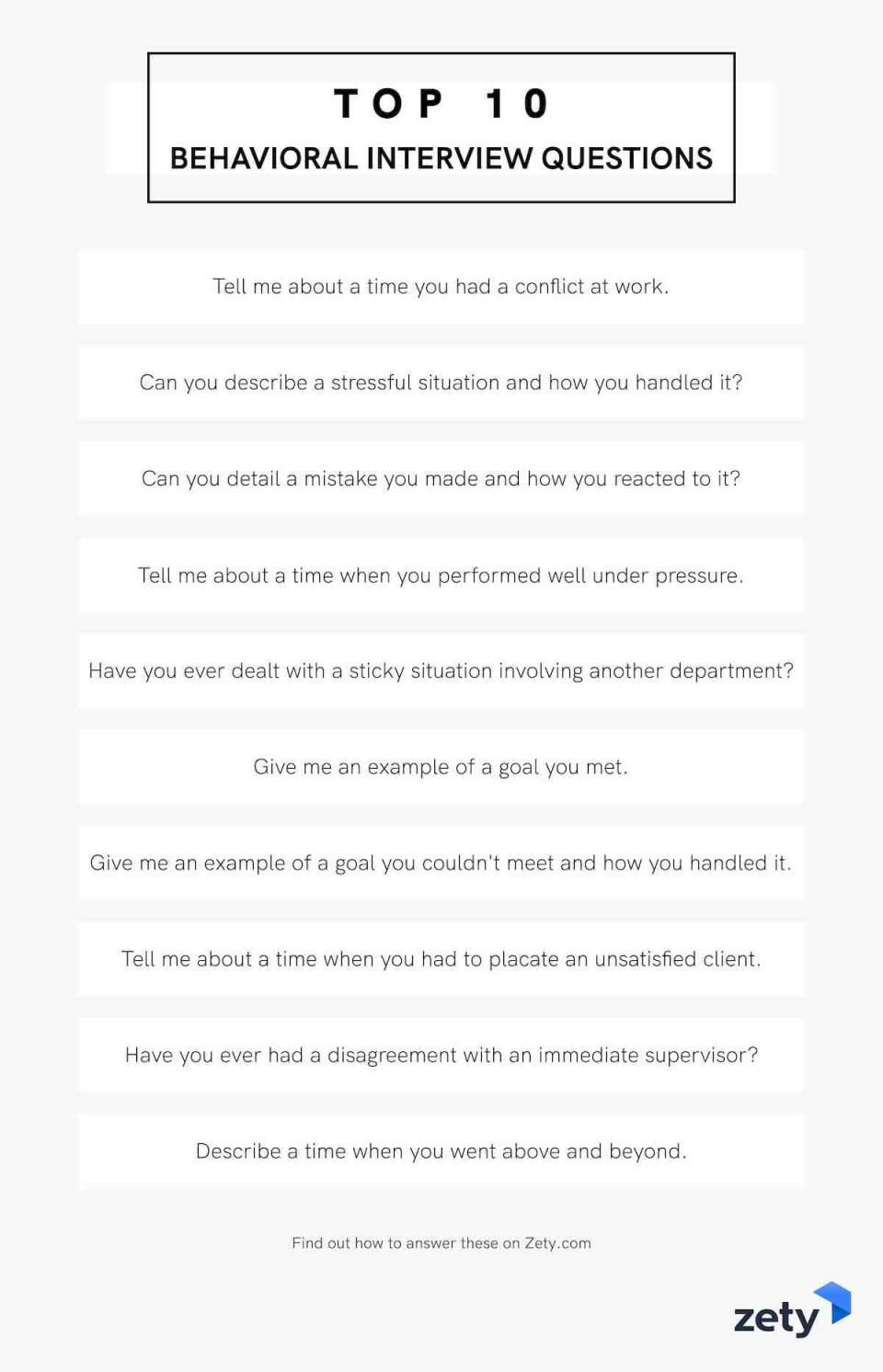
These are the most common behavioral questions at interviews, but for other common questions and how to answer them, see this: Common Job Interview Questions and Best Answers (20 Examples)
For behavioral interview questions, specifically, check out this great article: The Hidden Flaw In Behavioral Interview Questions (Forbes)
Plus, a great cover letter that matches your resume will give you an advantage over other candidates. You can write it in our cover letter builder here. Here's what it may look like:
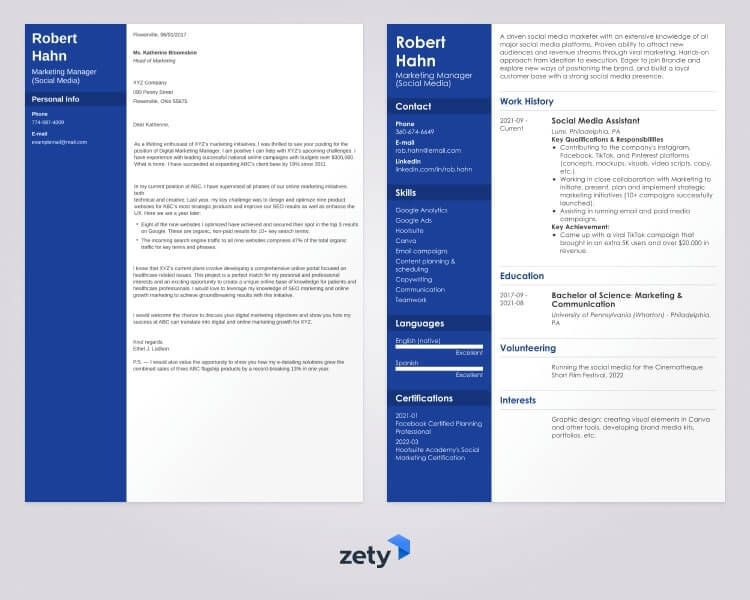
See more cover letter templates and start writing.
Key Takeaway
Behavioral questions for interviews may seem difficult to tackle at first glance, but with the STAR method, answering behavioral interview questions couldn't be more simple and straightforward.
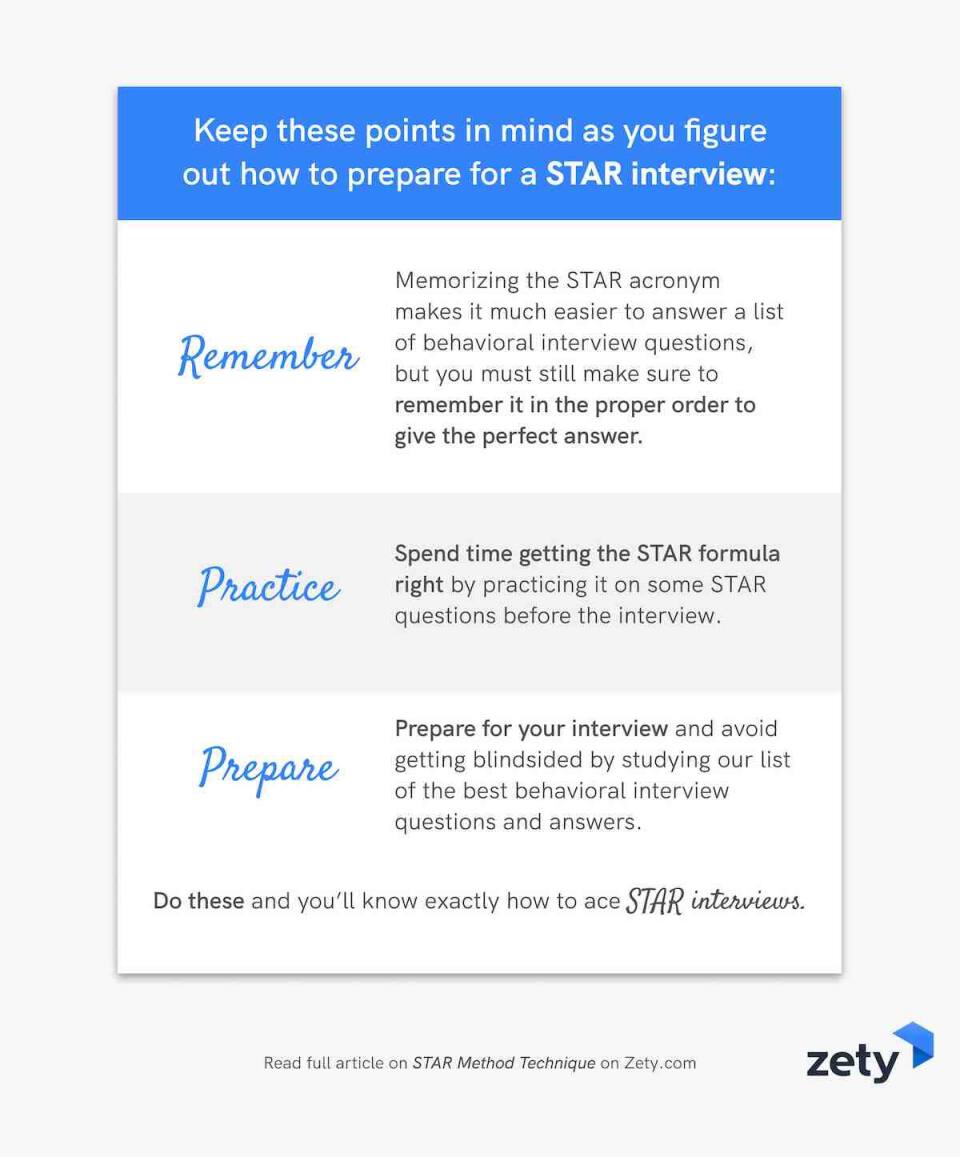
Keep these points in mind as you figure out how to prepare for a STAR interview:
- Remember - Memorizing the STAR acronym makes it much easier to answer a list of behavioral interview questions, but you must still make sure to remember it in the proper order to give the perfect answer.
- Practice - Spend time getting the STAR formula right by giving yourself some practice STAR questions and answers before the interview.
- Prepare - Prepare for your interview and avoid getting blindsided by studying our list of the best behavioral interview questions and answers.
Do these, and you'll know exactly how to ace STAR interviews.
Still not grasping the STAR acronym or what is the STAR interview technique? Not sure how to prepare for STAR interviews? Give us a shout in the comments below and we will answer your question. Thanks for reading!
What Does the Star Method Stand for
Source: https://zety.com/blog/star-method-interview